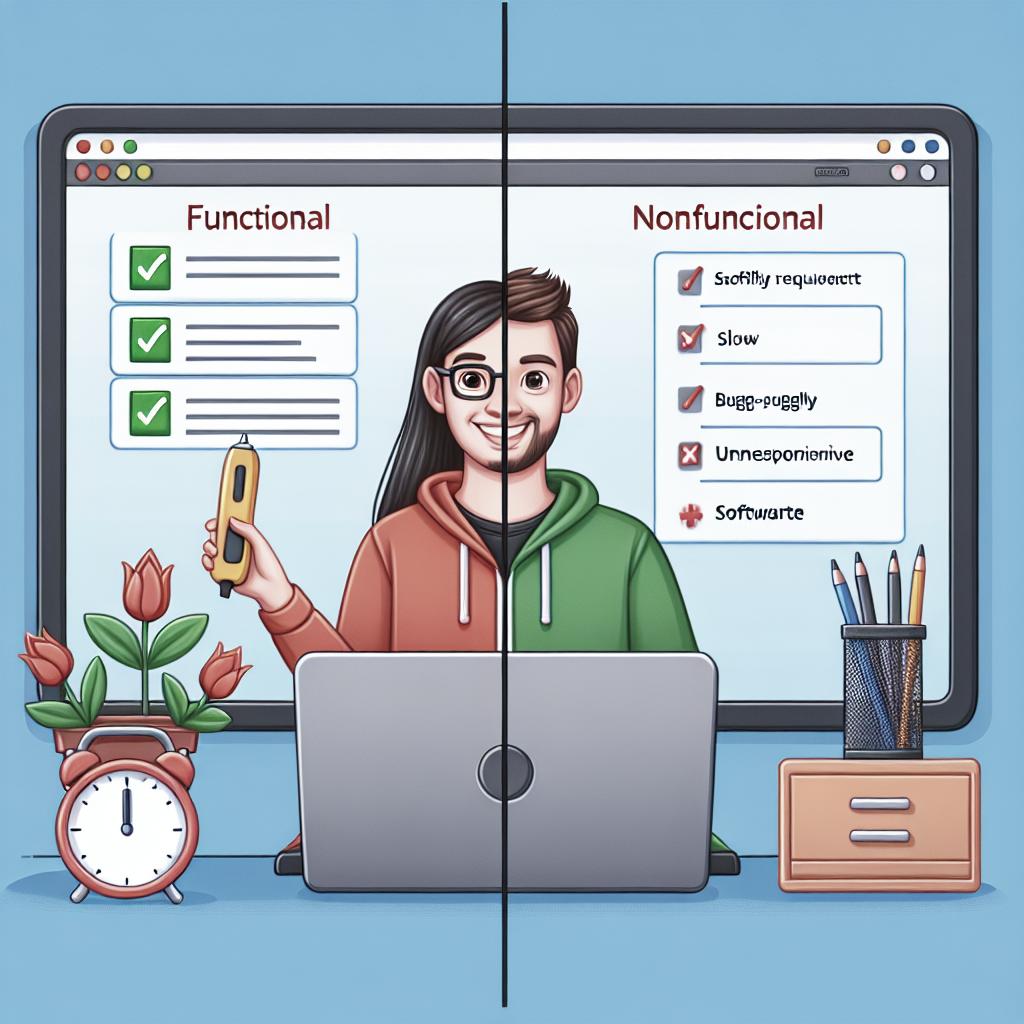Why Differentiating Between Functional and Nonfunctional Requirements Matters
Requirements are the foundation of any successful project, serving as clear guidelines and targets to ensure desired outcomes. Differentiating between functional and nonfunctional requirements is crucial as they address different aspects of a system’s needs. Functional requirements define the core operations and behaviors of a system, whereas nonfunctional requirements focus on attributes like performance and usability. This blog post dives deep into the types of requirements, illustrates examples, and explains their documentation and management. We further dissect functional and nonfunctional requirements, explore best practices for documentation, and highlight the importance of prototypes in understanding these requirements. By gaining a comprehensive understanding of these concepts, stakeholders can better align their expectations and contribute to the creation of effective, well-rounded solutions.
Types of requirements
Business requirements
Business requirements outline the high-level needs that a project seeks to fulfill for its stakeholders. They articulate the reasons and objectives behind a project, ensuring that the endeavor aligns with the company’s strategic goals. These requirements often manifest through business goals, policies, and procedures that define the expected business outcomes.
Effective business requirements are critical as they set the benchmark for project success. By providing a clear vision, they serve as a guiding framework for the direction of the entire project. Poorly defined business requirements can lead to misaligned priorities and project failure, hence the need for precision and clarity during the formulation phase.
User (stakeholder) requirements
User or stakeholder requirements focus on the needs and expectations of the people who will use the system. These requirements ensure that the final product will deliver maximum value to its users. Stakeholder requirements encompass user needs, business rules, and conditions that must be fulfilled.
Gathering accurate user requirements necessitates active engagement with stakeholders through meetings, interviews, and workshops. This ongoing communication encourages stakeholder buy-in and helps identify any hidden needs, which may otherwise be overlooked but are crucial for system acceptance.
Solution requirements
Solution requirements delve deeper into the specifications necessary to implement the intended solution. They can be divided into functional and nonfunctional requirements, describing what the system should do and the quality attributes of its execution, respectively.
Well-defined solution requirements facilitate an understanding among developers, testers, and stakeholders about the technical and non-technical facets of the system, contributing to a cohesive development process. Bridging the gap between what users want and the system’s ultimate design, these requirements help manage expectations and facilitate superior outcomes.
Transition requirements
Transition requirements encompass the needs and conditions necessary for transitioning from the current state to the desired future state. These requirements are significant during change management processes, ensuring a smooth transition without disruptions.
By adequately addressing transition requirements, organizations can minimize resistance and maximize adoption efficiency. This involves training, data migration, and ensuring operational continuity throughout any changes, fostering a seamless user experience.
Functional vs nonfunctional requirements
What are functional requirements?
Functional requirements specify the behavior and functionality of a system. They detail what the system should do, encompassing tasks, actions, and processes. These requirements are often documented through use cases, user stories, and business rules.
A clear understanding and documentation of functional requirements help developers create a system that meets the precise needs of its users while ensuring alignment with business objectives. These requirements serve as a blueprint for development, guiding the project towards its intended goals.
Functional requirements examples
Examples of functional requirements include user authentication processes, transaction handling, data processing, and user interface components. These requirements often detail the specific interactions between the system and its users, ensuring a seamless experience.
For instance, a functional requirement for an e-commerce site might state, “The system shall allow users to search for products by entering a keyword in the search bar.” This requirement outlines the specific functionality expected from the system, providing clarity and direction for development.
What are nonfunctional requirements?
Nonfunctional requirements describe the quality attributes, performance, and constraints of a system. They focus on how the system performs specific tasks rather than what it does. These include usability, reliability, security, and scalability.
Unlike functional requirements, nonfunctional requirements can be subjective and more challenging to quantify. Yet, they are essential in ensuring the system delivers a high-quality user experience while meeting operational efficiency standards.
Nonfunctional requirements examples
Examples of nonfunctional requirements include system reliability metrics (like uptime), response time for user requests, and compliance with security standards. These requirements are critical in providing a robust user experience.
A nonfunctional requirement for a banking application might be, “The system should support 10,000 concurrent users without performance degradation,” focusing on performance and scalability attributes critical to user satisfaction and business continuity.
Functional requirements types
Functional requirements can be further categorized into various types: data handling, user interactions, process logic, and system operations. Data handling requirements specify how the system should manage and process data, ensuring accuracy and consistency.
User interaction requirements outline the expected interactions between users and the system. Process logic requirements define the rules and algorithms that dictate system behavior, while system operations requirements specify the operations required to maintain system efficacy.
Nonfunctional requirements types
Usability
Usability requirements focus on ensuring that the system is intuitive and easy to use. This includes considerations for design aesthetics, user interface intuitiveness, and error recovery processes. Satisfaction and ease of use can significantly impact user adoption rates.
A well-designed system considers user feedback and continuous usability testing to create interfaces that cater to a diverse user base, ensuring accessibility and a seamless user experience across various devices and platforms.
Security
Security requirements emphasize the protection of data and system integrity against unauthorized access or manipulation. This includes encryption, authentication, authorization, and audit logging to ensure compliance with legal and organizational standards.
Robust security measures not only protect sensitive information but also instill confidence among users and stakeholders, preventing data breaches and maintaining the organization’s reputation.
Reliability
Reliability requirements ensure that the system performs consistently under expected conditions and recovers gracefully from any errors. This includes system uptime, fault tolerance, and failover capabilities.
High reliability minimizes downtime, enhancing user trust and operational efficiency. Establishing clear reliability metrics helps organizations measure system performance and make necessary improvements over time.
Performance
Performance requirements dictate the speed and responsiveness of a system, crucial for user satisfaction. They include metrics such as response time, throughput, and processing speed, enabling organizations to meet user expectations and maintain competitive advantages.
Performance improvements can often be achieved through optimized coding practices, efficient resource management, and continuous monitoring to ensure real-time performance tuning and problem identification.
Availability
Availability requirements ensure that the system remains accessible to users as needed. This involves maintaining high uptime percentages, backup processes, and disaster recovery planning to guarantee operational continuity.
Effective planning and regular testing of availability measures minimize disruptions and ensure that services remain operational and accessible during peak demand and adverse conditions.
Scalability
Scalability involves the system’s ability to handle increased loads sustainably. This includes the system’s capacity to scale up (improving existing resources) or scale out (adding more resources) to meet growing demands.
Without appropriate scalability, systems may face bottlenecks or service disruptions. Planning for scalability ensures that a system can accommodate growth effectively, supporting long-term business objectives and user expectations.
Requirements gathering and management
Gathering and managing requirements is a critical phase in project development, ensuring that all expectations align with stakeholder needs and system capabilities. This often involves conducting interviews, surveys, workshops, and analyses to collect comprehensive requirements.
Effective requirements management involves documenting, analyzing, prioritizing, and validating requirements to prevent scope creep and conflicts. Utilizing requirement management tools enhances communication, reduces errors, and facilitates traceability throughout the project lifecycle.
Functional and nonfunctional requirements documents
Product and software requirements documents
Requirements documents serve as official records outlining functional and nonfunctional requirements. These documents provide clarity for developers, testers, and stakeholders, eliminating uncertainties and facilitating smooth project execution.
These documents should be dynamic, allowing for changes and updates as new insights emerge. They serve as reference points throughout the project, ensuring that requirements remain aligned with business objectives and stakeholder expectations.
Functional decomposition and Work Breakdown Structures (WBS)
Functional decomposition involves breaking down complex processes into manageable components, making it easier to understand and address specific functional requirements. This method promotes clarity and facilitates task allocation and progress tracking.
A Work Breakdown Structure (WBS) complements functional decomposition by organizing project tasks into a hierarchical structure. This ensures comprehensive coverage of requirements, aids project planning, and enables effective resource allocation and time management.
Requirements formats: use cases and user stories
Use cases
Use cases are tools for documenting functional requirements, describing interactions between a user (or actor) and a system to achieve a goal. They provide clear scenarios that illustrate system functionalities from a user’s perspective.
Effective use cases help identify user roles and system behaviors, facilitating understanding and communication among stakeholders. They provide a framework for testing and validating system functions, ensuring comprehensive requirements coverage.
User stories
User stories capture stakeholder requirements in simple, narrative formats, emphasizing value to users. Originating from Agile methodologies, they focus on short, incremental tasks with clear deliverables, offering flexibility and adaptability.
User stories foster collaboration among stakeholders by prompting discussions around user needs and system functionalities. They encourage iterative development practices, aligning stakeholder expectations with project outputs.
Best practices for documenting requirements
Effective documentation practices enhance communication and understanding among stakeholders. Best practices include using clear, precise language, maintaining consistency, and leveraging visual aids like diagrams and models to illustrate complex concepts.
Regular reviews and updates to documentation ensure it remains relevant and accurate. Engaging stakeholders throughout the documentation process promotes transparency, collaboration, and alignment with project objectives and user needs.
Prototypes: understanding and testing requirements
Prototypes provide a tangible representation of a project, offering stakeholders a glimpse of potential technological solutions. By visually simulating functionalities, prototypes facilitate requirement validation and uncover hidden requirements at early stages.
Involving stakeholders in prototype evaluations enhances feedback efficiency and mitigates risks by aligning design and functionality with expectations. Prototypes allow iterative refinements, culminating in improved design decisions and better end-user satisfaction.
Next steps
| Section | Content Summary |
|---|---|
| Types of requirements | Discusses business, user, solution, and transition requirements and their importance. |
| Functional vs nonfunctional requirements | Explains functional and nonfunctional requirements with definitions and examples. |
| Functional requirements types | Details types of functional requirements like data handling and user interactions. |
| Nonfunctional requirements types | Explores usability, security, reliability, performance, availability, and scalability. |
| Requirements gathering and management | Emphasizes methods and tools for effective requirement gathering and management. |
| Functional and nonfunctional requirements documents | Discusses the importance of product documents and work breakdown structures. |
| Requirements formats: use cases and user stories | Provides insights into utilizing use cases and user stories for requirements documentation. |
| Best practices for documenting requirements | Highlights best practices for effective and efficient requirements documentation. |
| Prototypes: understanding and testing requirements | Explains the role of prototypes in validating and refining requirements. |


